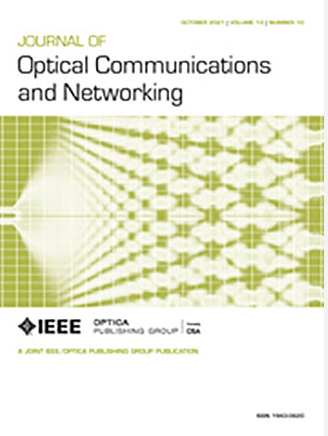Deep reinforcement learning-aided multi-step job scheduling in optical data center networks
IF 4.3
2区 计算机科学
Q1 COMPUTER SCIENCE, HARDWARE & ARCHITECTURE
引用次数: 0
Abstract
Orchestrating job scheduling and topology reconfiguration in optical data center networks (ODCNs) is essential for meeting the intensive communication demand of novel applications, such as distributed machine learning (ML) workloads. However, this task involves joint optimization of multi-dimensional resources that can barely be effectively addressed by simple rule-based policies. In this paper, we leverage the powerful state representation and self-learning capabilities from deep reinforcement learning (DRL) and propose a multi-step job schedule algorithm for ODCNs. Our design decomposes a job request into an ordered sequence of virtual machines (VMs) and the related bandwidth demand in between, and then makes a DRL agent learn how to place the VMs sequentially. To do so, we feed the agent with the global bandwidth and IT resource utilization state embedded with the previous VM allocation decisions in each step and reward the agent with both team and individual incentives. The team reward encourages the agent to jointly optimize the VM placement in multiple steps to pursue successful provisioning of the job request, while the individual reward favors advantageous local placement decisions, i.e., to prevent effective policies being overwhelmed by a few subpar decisions. We also introduce a penalty on reconfiguration to balance between performance gains and reconfiguration overheads. Simulation results under various ODCN configurations and job loads show our proposal outperforms the existing heuristic solutions and reduces the job-blocking probability and reconfiguration frequency by at least深度强化学习辅助光数据中心网络多步作业调度
在光数据中心网络(ODCNs)中协调作业调度和拓扑重构对于满足分布式机器学习(ML)工作负载等新型应用的密集通信需求至关重要。然而,这项任务涉及到多维资源的联合优化,而简单的基于规则的策略几乎无法有效地解决这一问题。在本文中,我们利用深度强化学习(DRL)强大的状态表示和自学习能力,提出了一种用于odcn的多步作业调度算法。我们的设计将作业请求分解为有序的虚拟机(vm)序列和其间的相关带宽需求,然后使DRL代理学习如何按顺序放置虚拟机。为此,我们在每个步骤中向代理提供嵌入在先前VM分配决策中的全局带宽和IT资源利用状态,并通过团队和个人激励来奖励代理。团队奖励鼓励代理在多个步骤中共同优化VM放置,以追求工作请求的成功供应,而个人奖励倾向于有利的局部放置决策,即防止有效的策略被一些低于标准的决策所淹没。我们还引入了对重新配置的惩罚,以平衡性能增益和重新配置开销。在各种ODCN配置和作业负载下的仿真结果表明,我们的方案优于现有的启发式解决方案,并将作业阻塞概率和重新配置频率分别降低了7.35 \times$和4.59 \times$。
本文章由计算机程序翻译,如有差异,请以英文原文为准。
求助全文
约1分钟内获得全文
求助全文
来源期刊
CiteScore
9.40
自引率
16.00%
发文量
104
审稿时长
4 months
期刊介绍:
The scope of the Journal includes advances in the state-of-the-art of optical networking science, technology, and engineering. Both theoretical contributions (including new techniques, concepts, analyses, and economic studies) and practical contributions (including optical networking experiments, prototypes, and new applications) are encouraged. Subareas of interest include the architecture and design of optical networks, optical network survivability and security, software-defined optical networking, elastic optical networks, data and control plane advances, network management related innovation, and optical access networks. Enabling technologies and their applications are suitable topics only if the results are shown to directly impact optical networking beyond simple point-to-point networks.

 求助内容:
求助内容: 应助结果提醒方式:
应助结果提醒方式:


